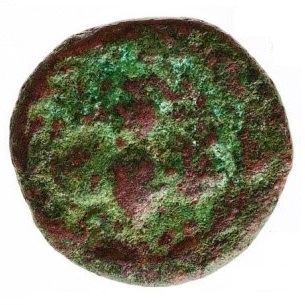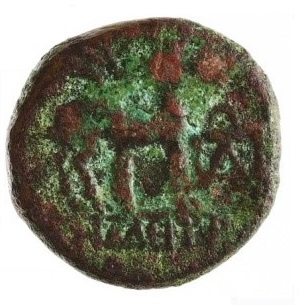Title: Bronze coin of Ephesos - 1997.01
Acquisition number: 1997.01
Author or editor: Douglas Kelly
Culture or period: Hellenistic.
Date: c. 202 -133 BC.
Material: Metal - Bronze
Object type: Coins - Greek
Dimensions: 18mm (w)
Origin region or location: Türkiye
Origin city: Ephesos.
Display case or on loan: 5
Keywords: Coin, Greek, Hellenistic, Ionia, Ephesos, Artemis
D.R. Sear, Greek Coins and their Values, vol. 1, Europe (London, Seaby, 1978), 4411.
Sylloge Nummorum Graecorum, Copenhagen, The Royal Collection of Coins and Medals, Danish National Museum, repr. edn (West Milford, NJ, 1981-), 301.
Classical Numismatic Group Auction, 287 lot 168.
1997.01
Bronze coin of Ephesos
3.71 g. 18 mm. c. 202-133 BC.
Obv.: Bee in laurel wreath.
Rev.: Stag facing r., in front of palm-tree; to right, monogram; in exergue probable name of magistrate.
The bee on the obverse of the coinage of Ephesos is found from the beginning of this city’s coinage in the early fifth century BC. The bee was the symbol of Artemis, the goddess of the wild and of wild things, whose temple at Ephesos, the Artemision, was one of the largest and most celebrated in the Greek world. The priestesses of Artemis there were known as melittai,‘bees’.
Ephesos introduced a base metal coinage c. 359 BC and, as can be seen, the bronze coinage also continued with the bee and stag coinage (albeit with some newer types) well into Roman times. The introduction of bronze coins in the fourth century BC replaced tiny silver fractions such as the hemi-obol.
Contemporary with 1985.03.
Presented to the Classics Museum by Mrs Elizabeth Gilchrist.
D.R. Sear, Greek Coins and their Values, vol. 1, Europe (London, Seaby, 1978), 4411.
Sylloge Nummorum Graecorum, Copenhagen, The Royal Collection of Coins and Medals, Danish National Museum, repr. edn (West Milford, NJ, 1981-), 301.
Classical Numismatic Group Auction, 287 lot 168.

